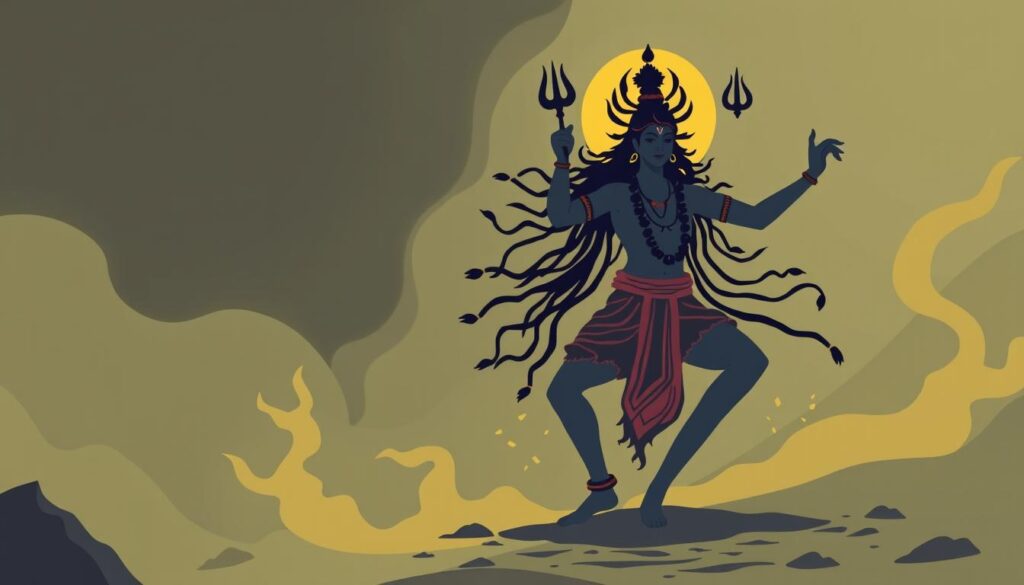As the sun’s golden rays peeked through the temple windows, the air was filled with the melodious chanting of the Shiv Tandav Stotram. Devotees from all walks of life gathered, their eyes closed in reverence. The powerful verses resonated through the sacred space.
This ancient Sanskrit hymn, composed by the legendary Ravana, has captivated the hearts of millions. It transcends geographical and cultural boundaries.
The Shiv Tandav Stotram, consisting of 15 verses, explores Lord Shiva’s cosmic dance, known as the Tandava. Each verse pays tribute to the divine form and infinite energy of the Lord. He is believed to be the embodiment of creation, preservation, and destruction.
This sacred hymn is revered for its spiritual significance. It is said to invoke Lord Shiva’s blessings, remove obstacles, and bring about a profound sense of inner peace and transformation.
Key Takeaways
- The Shiv Tandav Stotram is an ancient Sanskrit hymn composed by the devout devotee Ravana, praising Lord Shiva’s cosmic dance of Tandava.
- The hymn consists of 15 verses that explore the divine form and infinite energy of Lord Shiva, the embodiment of creation, preservation, and destruction.
- The Shiv Tandav Stotram is revered for its spiritual significance, believed to invoke Lord Shiva’s blessings and remove obstacles.
- The hymn captivates millions of devotees worldwide, transcending geographical and cultural boundaries.
- Reciting the Shiv Tandav Stotram is said to bring about spiritual awakening and inner peace.
Origin and Historical Significance
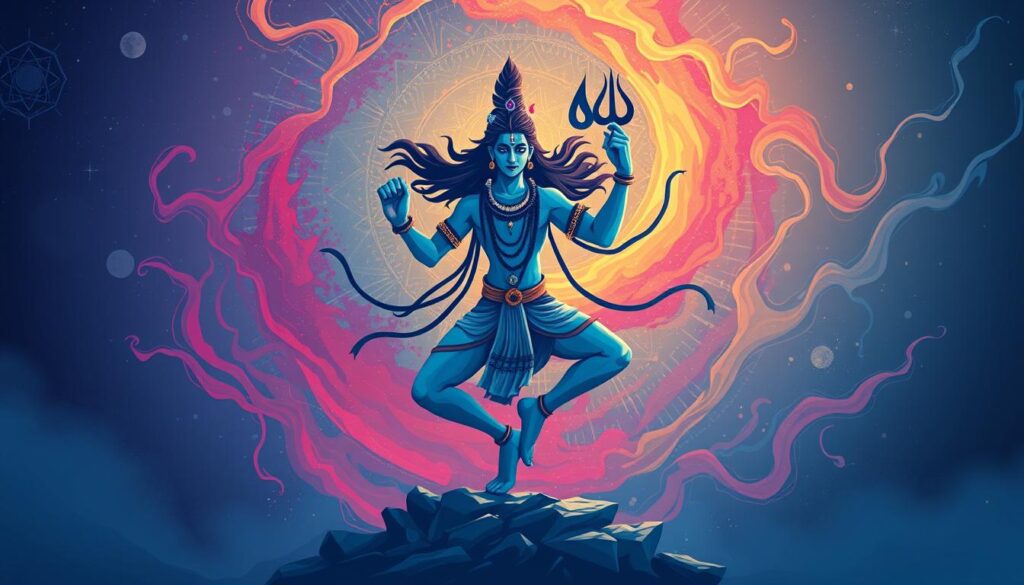
The Shiv Tandav Stotram comes from the deep devotion of Ravana. It says Ravana, the ruler of Lanka, saw Lord Shiva’s cosmic dance, the Tandava. Moved by this, Ravana wrote this beautiful hymn to Shiva.
This hymn has a long history, showing the universe’s dynamic forces. Its verses talk about creation, preservation, and destruction. They show the endless dance of Lord Shiva.
The Legend of Ravana’s Devotion
Ravana, the demon king, loved Lord Shiva deeply. He sang Shiva’s praises for a thousand years. The Shiv Tandav Stotram is one of Ravana’s many songs to Shiva.
Historical Context of the Sacred Hymn
The Shiv Tandav Stotram has lasted through time, touching many hearts. It’s a key part of Hindu worship, heard in temples and homes. It has enriched the lives of many.
Cultural Impact Through Ages
The Shiv Tandav Stotram has shaped Indian culture. Its verses have been used in Indian films. Its lasting appeal and spiritual power make it a beloved part of Hindu tradition.
Understanding Shiv Tandav Stotram
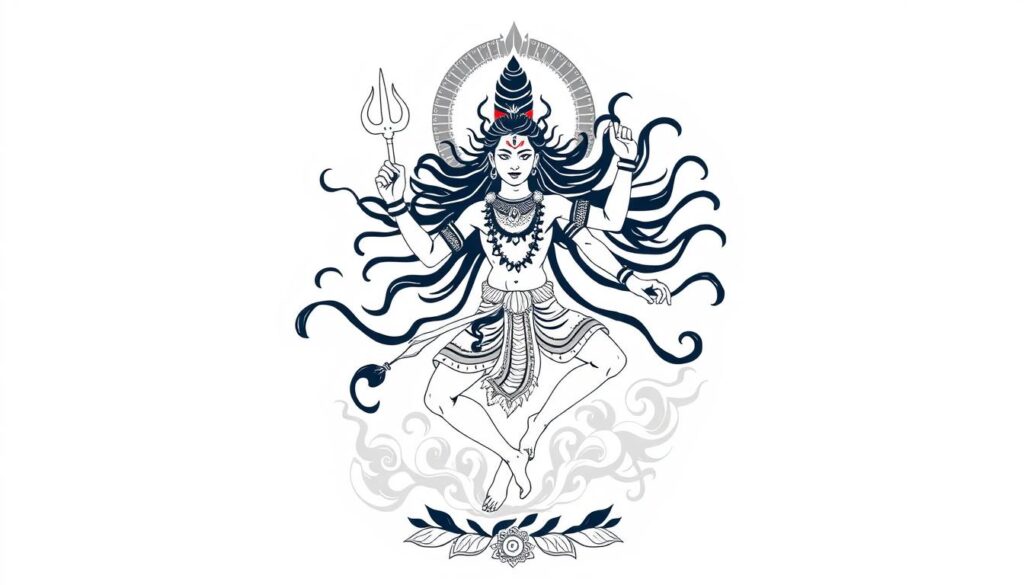
The Shiv Tandav Stotram is a deep spiritual hymn. It explores the cosmic energy and divine power in Lord Shiva’s dance. Each verse talks about Lord Shiva’s form, attributes, and the cosmic dance.
This hymn is more than just praising the Lord. It’s a deep thought on existence, the balance of dark and light, and the divine’s power. By understanding the Shiv Tandav Stotram, one starts a spiritual journey of awakening and change.
The hymn has 15 verses that show the grandeur and mystery of Lord Shiva’s dance. Each verse uses complex metaphors and vivid images. It shows the many sides of the divine Lord, from his looks to his cosmic attributes.
| Key Highlights of the Shiv Tandav Stotram | Description |
|---|---|
| Number of Verses | 15 |
| Composition | Attributed to the legendary Ravana |
| Significance | Describes the cosmic dance of Lord Shiva and its spiritual significance |
| Benefits | Believed to confer power, beauty, and mental strength to the devotee |
| Auspicious Timings | Eclipses, dawn, dusk, and Pradosh Vrat |
By understanding the Shiv Tandav Stotram, devotees can connect deeply with the divine. They can tap into the transformative energies of Lord Shiva’s dance.
“The Shiv Tandav Stotram is a sacred hymn that transports the devotee to the very heart of the divine, unveiling the mysteries of creation and destruction.” – Renowned Sanskrit scholar
The Divine Dance of Destruction and Creation
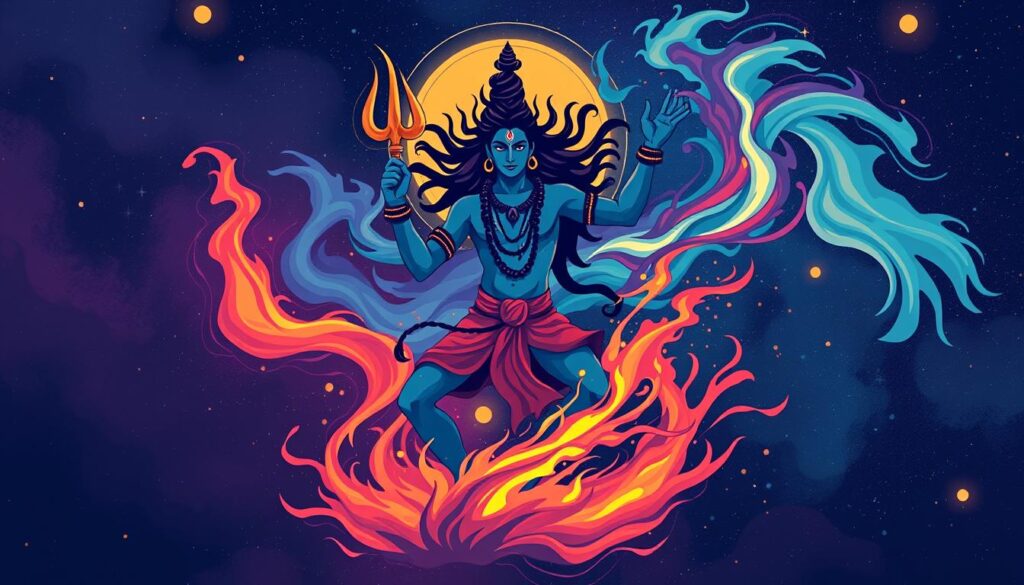
The Tandava dance of Lord Shiva is a captivating symbol of the universe’s cycles. It shows creation, preservation, and destruction. Each movement in the dance represents different cosmic processes and energies.
Symbolism of Tandava Dance
The Nataraja form of Lord Shiva performing the Tandava is a powerful visual metaphor. His graceful poses and rhythmic movements symbolize life and death. They show the balance between order and chaos and the unity of the universe.
Cosmic Energy and Movement
The Tandava dance vividly shows the cosmic energy and movement. Its steps and gestures mimic the orbits of celestial bodies and the flow of cosmic forces. It’s a deep expression of the eternal dance of lord shiva’s dance of primordial creation.
Spiritual Significance of Lord Shiva’s Dance
The cosmic dance of shiva holds deep spiritual meaning. It symbolizes the eternal cycle of life and death. It shows the link between creation and destruction and the reality beyond these dualities. Through this divine nataraja dance, Lord Shiva teaches us about the ever-changing universe and finding harmony in it.
“The Tandava dance of Lord Shiva is a cosmic symphony, where the rhythms of creation and destruction intertwine, guiding us towards a deeper understanding of the mysteries of the universe.”
Sanskrit Verses and Their Structure
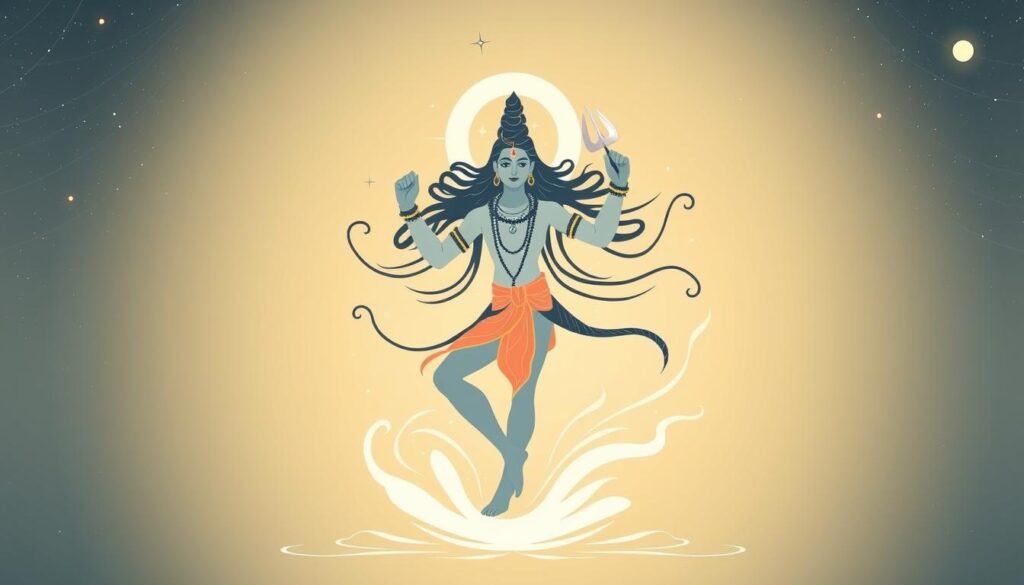
The Shiv Tandav Stotram is a sacred Hindu hymn with 16 verses. It was written by Ravana, a legendary poet. Each verse follows the Shikharini meter, making it perfect for chanting.
Each line has 17 syllables, blending Sanskrit words beautifully. This creates vivid images of Lord Shiva’s dance, the Ananda Tandava. It also connects to the idea of Nada Brahma, where the universe is born from sound.
The hymn is a deep expression of devotion and surrender. It shows how destruction leads to new beginnings. It invites us to join Lord Shiva’s eternal dance of creation and destruction.
| Verse Structure | Significance |
|---|---|
| 16 verses | The Shiv Tandav Stotram has 16 verses, each a masterpiece of Sanskrit poetry. |
| Shikharini meter | The verses are in the Shikharini meter, a popular form that makes the hymn melodious. |
| 17 syllables per line | Each verse has 17 syllables per line, adding to its musical quality and chantability. |
| Ravana’s authorship | The Shiv Tandav Stotram is attributed to Ravana, showing his skill in Sanskrit. |
The Shiv Tandava Shloka is a key part of Hindu devotion. It has inspired countless works of art, literature, and dance. Its enduring beauty and spiritual depth make it a precious part of Hindu devotional hymns.
Sacred Components and Mantras
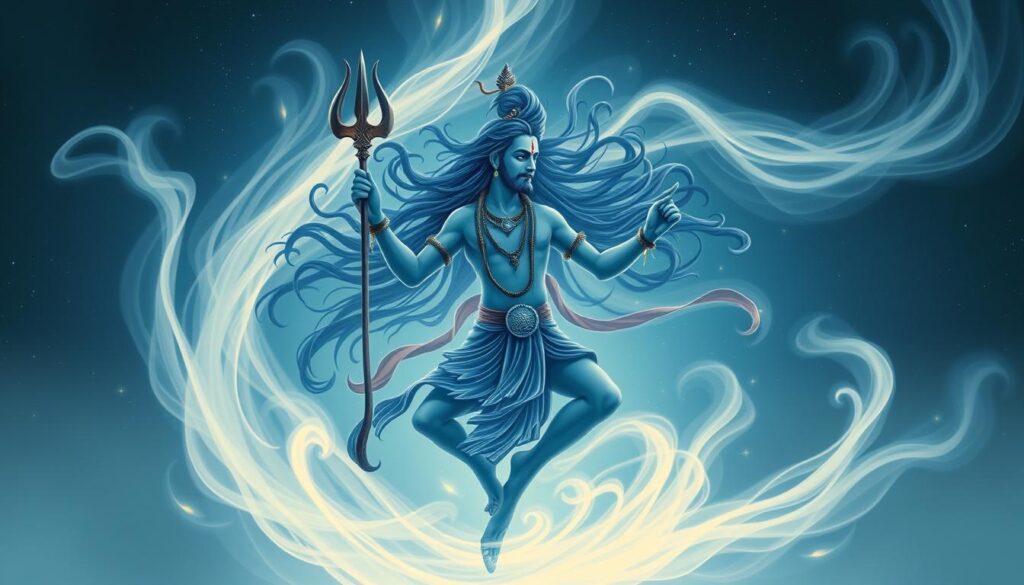
The Shiv Tandav Stotram is a sacred hymn for Lord Shiva. It has powerful Sanskrit phrases and mantras that devotees deeply respect. These parts of the stotram are key, guiding those who seek to connect with shiva tandava and lord shiva’s cosmic dance.
Key Sanskrit Phrases
The stotram includes many Sanskrit invocations and praises for Lord Shiva. The famous “Om Namah Shivaya” mantra is among them. These phrases, filled with Shiva’s essence, are chanted to seek his blessings and protection.
Pronunciation Guide
Reciting the Sanskrit verses correctly is vital for the shiv chalisa‘s effectiveness. Devotees must learn the right pronunciation of each word. This ensures the hymn’s power and their spiritual connection.
Rhythmic Elements
The Shiv Tandav Stotram has a unique meter and cadence. This makes it meditative and hypnotic. The rhythmic parts help focus the mind and lead to deep contemplation during recitation.
| Sanskrit Phrase | Meaning | Significance |
|---|---|---|
| “Om Namah Shivaya” | Salutations to Lord Shiva | One of the most revered mantras in Hinduism, invoking the divine presence of Shiva |
| “Isha Vasyam Idam Sarvam” | All this is pervaded by the Lord | A profound statement of the all-pervasive nature of the divine |
| “Tryambakam Yajamahe” | We worship the three-eyed one | An invocation of Shiva’s three eyes, representing the sun, the moon, and the fire |
Spiritual and Metaphysical Aspects

The Shiv Tandav Stotram is deeply rooted in Hindu metaphysics and spirituality. It explores profound concepts like the nature of reality and the cyclical dance of creation and destruction. This sacred hymn is often used in tantric practices and is seen as a powerful tool for spiritual transformation.
At the heart of the Shiv Tandav Stotram lies the metaphysical principle of Shiva. Shiva represents both the creative and destructive forces of the universe. The recitation of this vedic mantra is believed to invoke Shiva’s sacred energy, allowing the practitioner to tap into the infinite potential of the divine dance of life.
Through the rhythmic spiritual chanting of the stotram, the devotee embarks on a transformative journey. They shed the shackles of ego and align their inner being with the universal consciousness. The powerful vibrations generated by the chanting are said to cleanse the mind, body, and soul, paving the way for deeper spiritual insights and a heightened sense of oneness with the divine.
“The Shiv Tandav Stotram is a sacred symphony that resonates with the very fabric of the cosmos, inviting the seeker to become a part of the eternal dance of Shiva, the Destroyer and the Creator.”
By immersing themselves in the metaphysical depths of the Shiv Tandav Stotram, practitioners can unlock the doors to a profound understanding of existence. They gain insight into the interplay of cosmic forces and the transformative power of the divine within. This sacred hymn serves as a gateway to the timeless wisdom of the Vedas, guiding the devotee towards a state of heightened spiritual awareness and inner peace.
Proper Time and Methods of Recitation
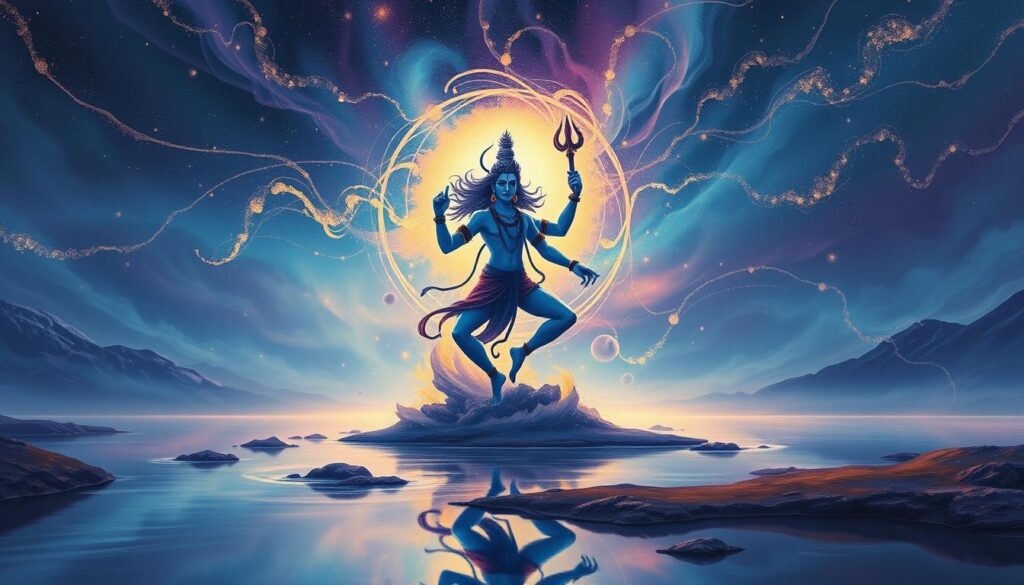
The sacred Shiv Tandav Stotram can be recited at any time. But, some periods are more auspicious. These include during eclipses, at dawn and dusk, and on Pradosh Vrat (the 13th day of each lunar fortnight).
To recite this divine hymn, you need a calm place. Focus and devotion are key. Also, saying the Sanskrit verses correctly is crucial.
Auspicious Timings
- During solar and lunar eclipses
- At dawn and dusk
- On Pradosh Vrat (13th day of each lunar fortnight)
Ritual Requirements
- Create a serene and peaceful environment
- Maintain unwavering focus and devotion
- Ensure proper pronunciation of the Sanskrit verses
The Shiv Tandav Stotram is a powerful call to the divine. It connects us with sanskrit literature, hindu mythology, and divine energy of Lord Shiva. By following the right times and rituals, we can strengthen our spiritual bond. This unlocks the deep benefits of this sacred hymn.
“The Shiv Tandav Stotram should be recited with utmost devotion, as it opens the door to the blessings and grace of Lord Shiva.”
Benefits of Chanting Shiv Tandav Stotram
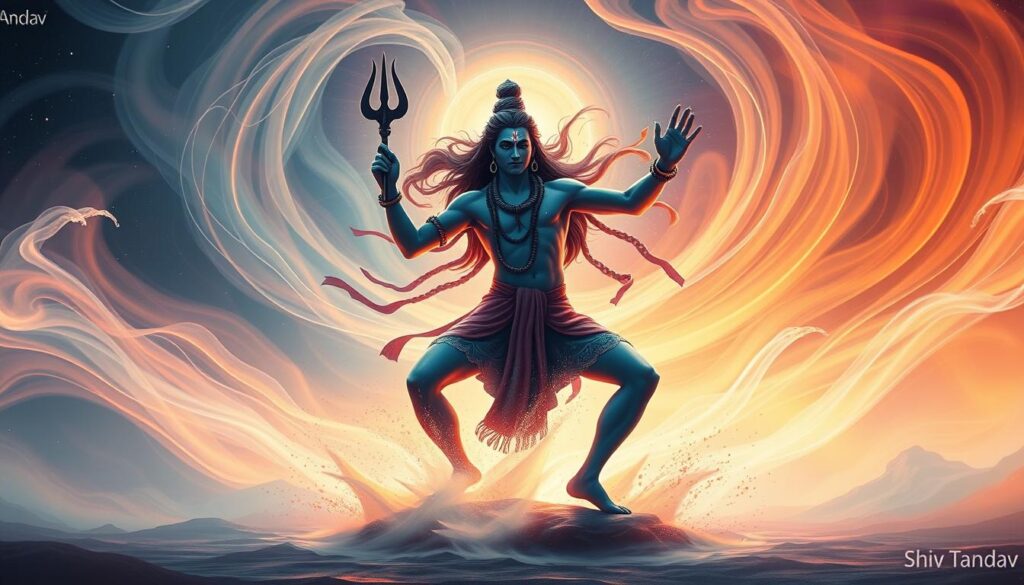
Reciting the Shiv Tandav Stotram is a sacred act that brings many benefits. This hymn, written by Ravana, is known for awakening spiritual awareness. It helps remove obstacles and grants divine grace.
Chanting the Shiv Tandav Stotram purifies the mind and soul. Its rhythmic verses calm the mind and bring inner peace. This leads to a clearer and more peaceful state of being.
The hymn also protects against negative forces. Lord Shiva’s power is invoked to keep away evil. This offers a divine shield to the devotee.
Chanting the Shiv Tandav Stotram boosts mental strength and physical beauty. It enhances overall well-being. Regular practice unlocks one’s full potential, leading to a life of abundance and growth.
The Shiv Tandav Stotram is also known for granting wishes. It has helped people in many ways, from solving marriage issues to achieving financial success. This shows its power in fulfilling desires.
The Shiv Tandav Stotram is a key to spiritual growth. It connects us deeply with Lord Shiva’s divine energy. By chanting it regularly, we can experience spiritual transformation and receive divine blessings.
“Chanting the Shiv Tandav Stotram is believed to make Lord Shiva pleased more quickly compared to other hymns.”
Understanding the Verses’ Deep Meaning
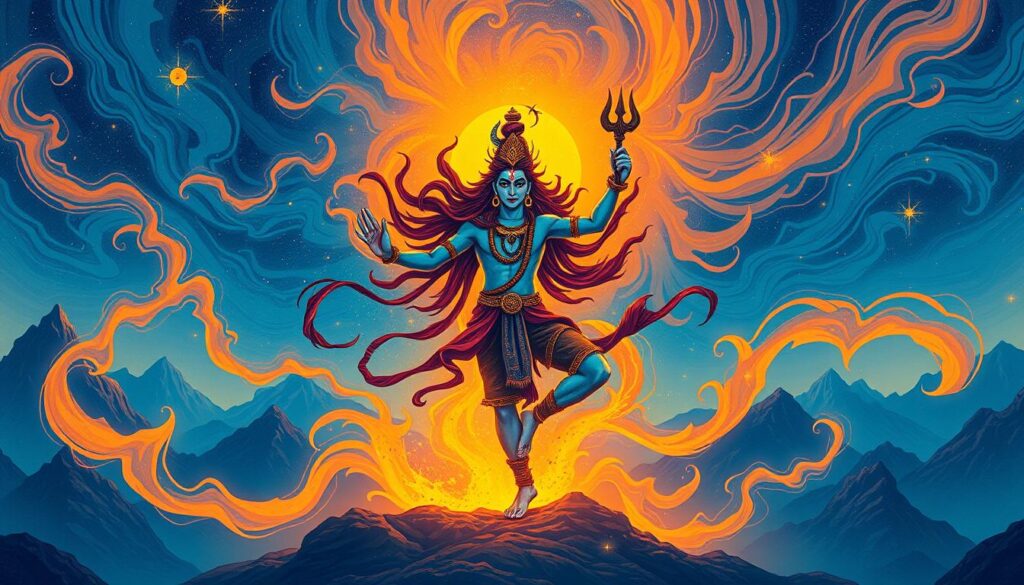
The Shiv Tandav Stotram is a sacred Hindu mantra for Lord Shiva. It shows his cosmic dance, Tandav, which means creation, preservation, and destruction. Each verse of this shiva stotra holds deep spiritual and philosophical meanings. These reveal the secrets of the divine.
Verse-by-Verse Analysis
Looking closely at the Shiv Tandav Stotram shows us a lot about Lord Shiva. It talks about his forms, like the moon on his head and a snake around his neck. It also mentions the Damaru, a sacred drum.
Hidden Symbolism
The Shiv Tandav Stotram is full of symbols with deep spiritual truths. For example, Ravana climbing Mount Kailash to praise Shiva shows the divine’s victory over ego. It teaches us to surrender to the Supreme Lord.
Exploring these symbols can give us deep spiritual insights. It helps us connect more with Lord Shiva, the shiva panchakshari mantra, and the shiva sacred chants. These celebrate his divine presence.
“The Shiv Tandav Stotram is a gateway to unlock the mysteries of the cosmos and the divine dance of Lord Shiva, guiding devotees on a transformative journey of spiritual awakening.”
Role in Modern Spiritual Practice
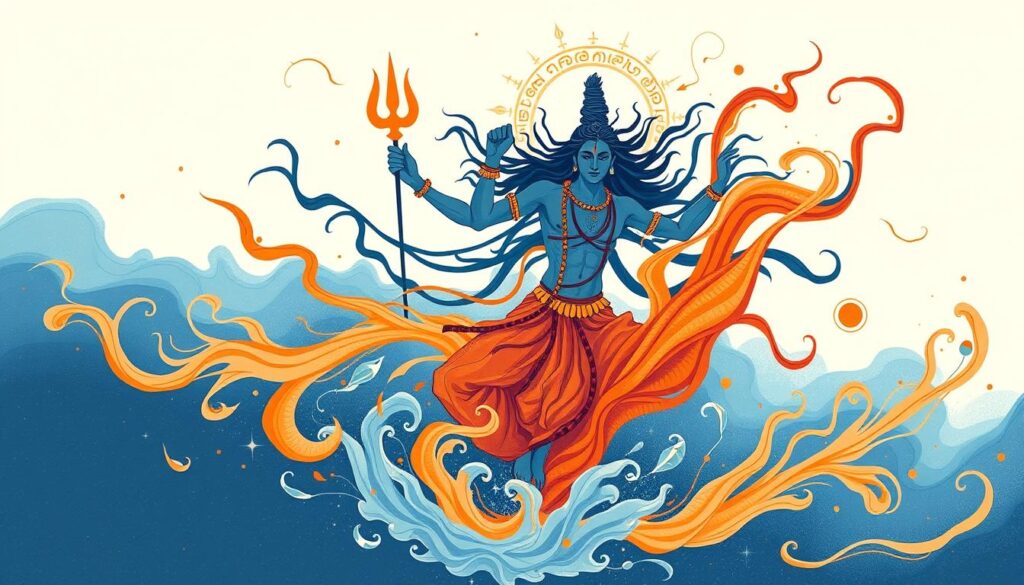
The Shiv Tandav Stotram is a sacred hymn that honors Lord Shiva’s cosmic dance. It is a timeless Sanskrit verse written by the legendary sage Ravana. It is widely revered and used in personal devotion, group worship, and spiritual retreats across India.
Many spiritual leaders and organizations today see the Shiv Tandav Stotram as powerful. Its description of tandav nritya, the dance of destruction and creation, is captivating. It also invokes the bhairava tandava hymns, making it a profound text for hindu prayer and meditation.
Devotees and seekers from all spiritual traditions find solace in the Shiv Tandav Stotram. Its themes of devotion, surrender, and the cycle of existence resonate with people today. The hymn evokes awe, humility, and a connection with the divine, attracting more spiritual enthusiasts.
“The Shiv Tandav Stotram is a masterpiece that transcends time and space, speaking to the heart of every seeker who yearns for a deeper understanding of the divine dance of existence.”
Hinduism is evolving, and the Shiv Tandav Stotram remains a cherished part of it. Its relevance and universality ensure it will continue to inspire and guide devotees. It helps them in their quest for spiritual enlightenment and connection with the divine.
Musical Aspects and Traditional Renditions
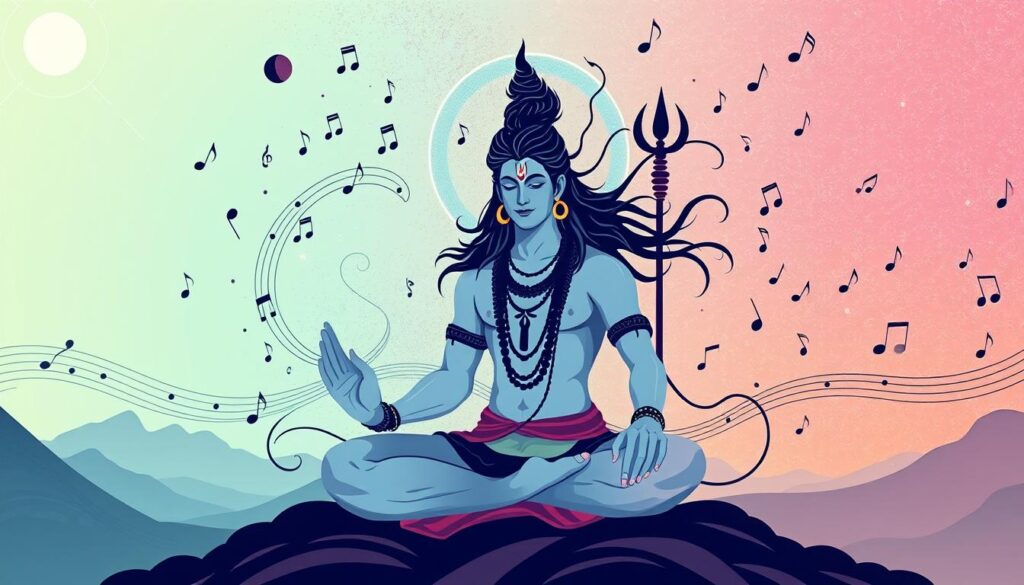
The Shiv Tandav Stotram is a sacred hymn to Lord Shiva. It has a rich musical history that has drawn devotees for centuries. This verse has been set to various classical Indian ragas and rhythms. It creates a symphony that echoes the divine energy of Shiva’s Tandava dance.
Many famous artists have sung the Shiv Tandav Stotram. They have mixed traditional chanting with modern music. These interpretations have helped make the stotram popular among the young and across cultures.
Renowned Interpretations
- The Vedic Chants – Mantras & Melodies album by singer Krishnaraj Ji is widely acclaimed as the best rendition of the Shiv Tandav Stotram.
- Ajay Atul’s version in the album Majhi Gaani is an energetic and dynamic representation of the stotram’s verses.
- Uma Mohan’s rendition in the Divine Chants of Shiva album is a popular choice for choreographing the Tandava dance.
- Unnikrishnan’s Shiva Stuthi album offers a slow-paced, meditative interpretation of the complete Shiv Tandav Stotram.
These different versions have kept the sacred legacy of the Shiv Tandav Stotram alive. They have also sparked a deeper love for Lord Shiva’s chants and the tandava dance of shiva worldwide.
| Artist | Album | Rendition Style |
|---|---|---|
| Krishnaraj Ji | Vedic Chants – Mantras & Melodies | Acclaimed as the best version |
| Ajay Atul | Majhi Gaani | Energetic and dynamic |
| Uma Mohan | Divine Chants of Shiva | Suitable for Tandava dance choreography |
| Unnikrishnan | Shiva Stuthi | Slow-paced, meditative version |
The Shiv Tandav Stotram’s sacred vedic hymns have been immortalized through these captivating musical renditions. They ensure that the divine essence of Lord Shiva’s tandava dance continues to inspire and enlighten devotees across generations.
Integrating the Stotram in Daily Worship
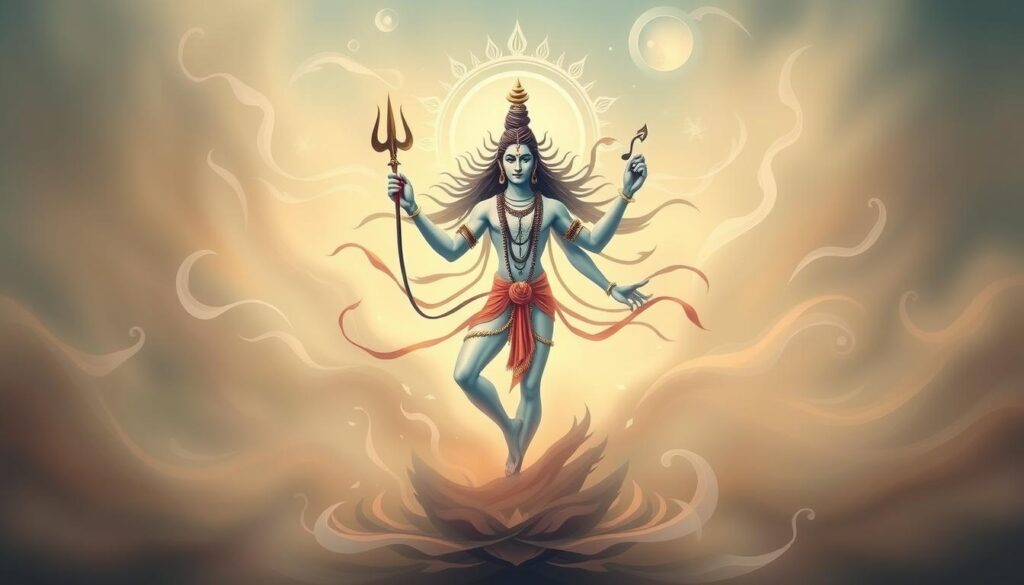
The Shiv Tandav Stotram is a sacred hymn written by Ravana, the demon king. It holds deep meaning in Hindu worship. Devotees can easily add this powerful Sanskrit stotram to their daily prayers. This helps them connect more deeply with Lord Shiva and his cosmic dance.
Many people recite the Shiv Tandav Stotram during morning or evening prayers. It becomes a key part of their spiritual practice. The hymn also helps in meditation, guiding them to understand Lord Shiva’s complex nature.
Listening to the Shiv Tandav Stotram in music is another way to include it in daily life. Musicians use instruments like the tabla, sitar, flute, and veena to bring the hymn to life. Their melodies capture the hymn’s deep symbolism and imagery.
By regularly using the Shiv Tandav Stotram, devotees grow closer to Lord Shiva and Hindu traditions. The spiritual devotional music and Sanskrit stotras in the hymn aid in personal growth and transformation.
“The Shiv Tandav Stotram is a powerful hymn that captures the essence of Lord Shiva’s cosmic dance, representing the cycle of creation, preservation, and destruction. Its recitation can be a transformative spiritual practice for devotees seeking a deeper connection with the divine.”
Adding the Shiv Tandav Stotram to daily worship enriches devotees’ spiritual journey. It deepens their devotion to Lord Shiva through the hymn’s symbolism, rhythm, and spiritual depth.
| Key Symbolic Elements in the Shiv Tandav Stotram | Spiritual Significance |
|---|---|
| Nataraja – Lord Shiva as the Lord of Dance | Represents the triumph over darkness and ignorance, highlighting the importance of knowledge for liberation. |
| Shiva’s Third Eye | Symbolizes spiritual wisdom and insight, demonstrating the ability to see beyond the material realm. |
| Damru – The Drum Held by Shiva | Symbolizes the rhythm of creation, the sound of the universe (Om), and the cycle of life and death. |
| Flame Held by Shiva | Represents destruction as a means of dissolving old structures, ideas, and illusions for new growth and purification. |
| Serpent Coiled Around Shiva’s Neck | Signifies his control over primal energy and instincts, emphasizing his mastery over time and death. |
| River Ganga Flowing from Shiva’s Hair | Symbolizes life, fertility, and spiritual cleansing, underlining the interconnectedness of destruction and creation. |
Conclusion
The Shiv Tandav Stotram is a sacred hymn written by Ravana, a renowned scholar and devotee. It shows the deep bond between humans and the divine cosmic energy of Lord Shiva. This shiva stotram has crossed time and culture, helping people grow spiritually and change for the better.
The shiva tandava shloka lets devotees connect with the universe’s cosmic dance. It talks about Lord Shiva’s Tandava dance, full of symbols and deep meaning. This dance invites seekers to explore their spiritual path.
The Shiv Tandav Stotram is still chanted and studied by many in India and worldwide. It shows the lasting impact of Hindu spiritual traditions. By understanding this sacred hymn, people can grasp the divine cosmic energy in all things. This enriches their lives and deepens their bond with the divine.
FAQ
What is the Shiv Tandav Stotram?
The Shiv Tandav Stotram is an ancient Sanskrit hymn. It was written by Ravana, a devoted follower of Lord Shiva. This hymn describes Lord Shiva’s cosmic dance, known as Tandava. It shows the cycle of creation, preservation, and destruction.
What is the historical significance of the Shiv Tandav Stotram?
The Shiv Tandav Stotram comes from Ravana’s deep love for Lord Shiva. It’s said Ravana wrote it after seeing Lord Shiva dance. The stotram’s history goes back to ancient times, capturing the forces of creation, preservation, and destruction.
What is the spiritual significance of the Shiv Tandav Stotram?
The Shiv Tandav Stotram is a deep expression of cosmic energy and divine power. It talks about Lord Shiva’s dance and its spiritual meaning. Each verse leads to spiritual awakening and inner change.
What does the Tandava dance of Lord Shiva symbolize?
The Tandava dance of Lord Shiva shows the cycles of creation, preservation, and destruction. Each dance move represents different cosmic processes. The Nataraja form of Lord Shiva dances as a symbol of the cosmic dance.
What is the structure and composition of the Shiv Tandav Stotram?
The Shiv Tandav Stotram has 15 Sanskrit verses. Each verse has its own structure and rhythm. It’s written in various Sanskrit meters, showing Ravana’s skill in language. It includes sacred phrases and mantras.
What are the key benefits of reciting the Shiv Tandav Stotram?
Reciting the Shiv Tandav Stotram brings many spiritual and worldly benefits. It awakens spiritual consciousness and removes obstacles. It purifies the mind and soul, protects from negative forces, and gives divine grace and blessings.
How can the Shiv Tandav Stotram be integrated into daily worship?
Devotees can add the Shiv Tandav Stotram to their daily worship. They can recite it during morning or evening prayers, use it for meditation, or listen to its music. Regularly engaging with the stotram deepens spiritual practice and connection with Lord Shiva.


